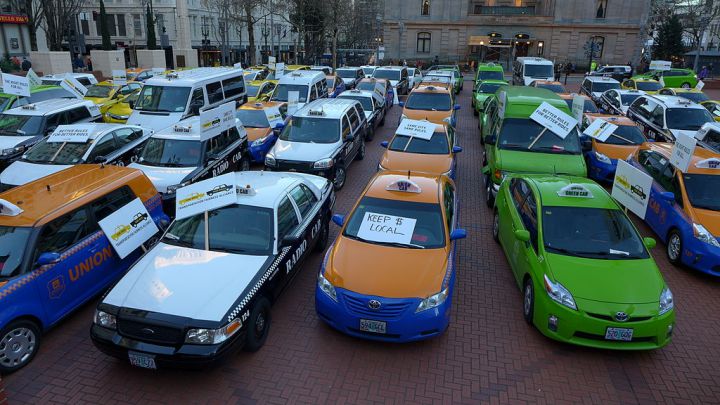New study by researchers at the Mercatus Center at George Mason University highlights the need to rethink taxi regulations.
“The natural progress of things,” Jefferson lamented is “for liberty to yield and government to gain ground.” Freedom—including economic freedom—may be optimal for both the individual and the society of which she is a part. But it is hardly a stable equilibrium.
The research of George Stigler explains why. It teaches us that businesses themselves often invite regulation because they stand to gain from it. The state, Stigler reminded us, possesses “one basic resource which in pure principle is not shared with even the mightiest of its citizens: the power to coerce.” This power permits the possibility of “the utilization of the state by an industry to increase its profitability.” Firms seek—and quite often obtain—regulations which limit entry, suppress substitutes, encourage complements, or fix prices above the competitive market equilibrium. The result is a maddeningly complex patchwork of rules which protect entrenched businesses (for a time) at the expense of consumers, would-be competitors, and progress itself. Though they find it lucrative in the short run, industries that profit from regulatory protections often stagnate over the long run. Thus, as Milton Friedman once put it, the pursuit of state protection is ultimately a “suicidal impulse.”
Yet occasionally the state retreats. The airline industry was partially deregulated in 1978, much to the benefit of consumers. Two years later, many regulations on interstate trucking were also repealed, yielding lower prices and better service.
In new research with our colleague Christopher Koopman, published by the Mercatus Center at George Mason University, we argue that urban taxi markets should be next.
The taxi industry has long been a textbook example of regulatory failure. Using Washington, D.C. as a case study, we show that a thicket of local rules limit entry and dictate operations at the driver, vehicle, and company level. These regulatory procedures—we count 33 in all—exceed the number of steps it takes to start a small business in Venezuela (14), Mozambique (19), or Bolivia (20), countries notorious for their steep regulatory burdens. They also come with a large price tag: a driver can spend up to $2,643 in fees and mandated equipment to get her car ready to be a taxicab. And because many of these fees are imposed at the company level, drivers who rent from major companies may not even know that the costs are being passed on to them in the form of higher rental prices.
Once in operation, regulations also dictate how drivers may conduct their businesses. These rules govern everything from the price a driver must charge and where she may pick up passengers, to how she must handle records and even the colors she must paint her car. These rules have long been portrayed by their defenders as necessary consumer protection measures that lessen the “asymmetric information” problem endemic to an industry in which riders have little choice but to accept the first taxicab that stops to pick them up.
The reality, however, is that these rules have manifestly worsened the customer experience:
- Price controls have forced prices above what would prevail in a competitive market.
- Steep entrance fees and burdensome barriers to entry have undermined competition.
- Mandated alterations to vehicles have created barriers to exit, thus deterring entry in the first place.
- And mandated business practices have “locked in” antiquated technologies and old business models.
Economic theory and decades of research suggest that these regulatory limits on competition have harmed consumers and would-be competitors more than they have helped incumbent producers. Moreover, they’ve made firms inattentive to consumer desires and costs while encouraging them to expend scarce resources pursuing regulatory privilege. These efforts to secure special favors are an enormously destructive phenomenon that economists call “rent-seeking.”
But there is hope.

Ironically, by dictating the most minute details of the industry’s operation, policy makers have created a significant profit opportunity for firms that can serve the same customer needs in an entirely different fashion. By employing new technologies and different business models, ridesharing firms such as Uber and Lyft have managed to be classified differently
than taxis in many U.S. jurisdictions, thus avoiding many of the most obnoxious taxi regulations. (This has happened before. Professor Diana Thomas has written about stifling medieval beer regulations that created an opportunity for firms to operate outside of the regulatory regime once technological change made those old rules obsolete.)
Like the intra-state (and therefore non-regulated) airline routes of the 1970s, these comparatively lightly-regulated firms offer an instructive comparison to highly-regulated taxis.
Comparing several popular routes in the D.C. area, we find that street-hailed taxi trips are up to 3 times more expensive than ridesharing trips. Moreover, customer feedback mechanisms provide instantaneous, detailed information about the driver, the ride, and the vehicle. These constantly evolving feedback mechanisms permit ridesharing firms to balance the information asymmetry better than a half-century of regulations have ever been able to. The result is a cheaper, more reliable, and higher quality vehicle-for-hire experience. This explains why ridesharing firms have rapidly gained market share. As we report:
As late as the first quarter of 2014, only 8 percent of business travelers who filed vehicle expense reports through the expense-reporting firm Certify used ridesharing firms, while 37 percent used taxis and the rest rented cars. By the first quarter of 2016, however, fully 46 percent of business travelers used ridesharing firms, while just 14 percent used taxis.
Ridesharing firms also seem to be drawing in new customers. A Portland study found that the city’s entire for-hire market was more than 60 percent larger just 4 months after ridesharing firms entered.
So regulations that were, as Stigler put it, “acquired by the industry,” and “designed and operated primarily for its benefit,” now stand in the way of the industry’s survival. This presents policy makers with a choice: level the regulatory playing field by deregulating taxis down to the same low-burden level of ridesharing firms or watch the taxi industry die an undignified death at the hands of regulations it once benefitted from.
(Note: Matthew Mitchell is a senior research fellow at the Mercatus Center at George Mason University, where he is the director of the Project for the Study of American Capitalism. He is also an adjunct professor of economics at Mason. Michael Farren is a Research Fellow in the Project for the Study of American Capitalism at the Mercatus Center.)






